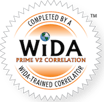Level Up Your Multilingual Learners
 Speak Agent is designed by ESL teachers and MLLs for ESL teachers and MLLs. It uses research-based strategies and learning scaffolds to boost student motivation, achievement, and growth mindset.
Speak Agent is designed by ESL teachers and MLLs for ESL teachers and MLLs. It uses research-based strategies and learning scaffolds to boost student motivation, achievement, and growth mindset.
Multilingual Learners (MLLs) Need a New Strategy
Only one in 20 learners identified as English Learners achieve Proficient level by eighth grade on the NAEP Math, Reading, and Science assessments (NAEP, 2017). Less than one in five MLLs achieve even Basic, which is the lowest level on the NAEP assessment, compared to 7 in 10 non-MLLs (ibid.). Nationally, less than one in four MLLs are able to exit English Learner programs each year (EDFacts, 2016). The past decade has not seen significant improvement in outcomes nationally. The current strategy is not working. While many individual localities and teachers may experience varying degrees of improvement, how do we scale and sustain success?
Help Your MLLs Outperform in K-8 Math, Algebra, Reading, and K-8 Science
No scalable intervention has produced evidence of promise for MLLs to learn the language of STEM—until now. With as little as 30 minutes of Content+Language™ instruction using Speak Agent for 12 weeks, treatment students in an NSF-sponsored study were able to increase targeted Science vocabulary and concept knowledge between 10% and 15% versus only 3% for the control group. Follow-on research in Montgomery County, MD corroborated this 3X acceleration in Science and found even greater gains (31%) in Reading at the same dosage. A small-scale study at KIPP found similar results on their own reading assessment—and also showed significant attitudinal changes toward reading. Follow-up studies are planned to explore these initial findings at greater scale.
 Examples of Multilingual Learning Supports
Examples of Multilingual Learning Supports
Viewing and Representing are built into everything we do!
Speak Agent Works Because It Is Evidence-Based
Proctor, August, Carlo, & Snow (2005) found that content area vocabulary was the most significant factor in general academic text comprehension among MLLs/ELLs. Another study (Arya, Hiebert, & Pearson, 2011) further found lexical complexity (of academic vocabulary) to be the only significant factor in ELL comprehension of texts. Many leading edtech products claim to include ESL supports, but treat academic language learning as a rote memorization task. A shallow approach limited to dictionary definitions, picture matching, and flashcards is typical. Speak Agent, on the other hand, goes far beyond isolated vocabulary practice and rote learning. It promotes an effective language development approach that includes listening, speaking, reading, and writing supports, in addition to ubiquitous visual aids (Graves, 2009; Nisbet & Austin, 2013). Efficacy also requires collaboration and communication among learners (Thorne & Black, 2007), rather than the purely independent practice too often promoted by education technologies. With Speak Agent, students engage in dialogic reading, morphology and sentence processing games, scaffolded writing activities—even creating their own math puzzles—all designed to develop comprehension of key academic concepts in varied contexts. This variety of contexts and modes is helpful for understanding nuanced meanings and fluency with science texts (Bravo et al., 2007; Graves, 2009; Nisbet & Austin, 2013; Peregoy & Boyle, 2013).Correlated to WIDA Standards
Learn how Speak Agent supports the 2020 Edition here. Please contact us if you need a current copy of the Speak Agent WIDA PRIME V2 correlations.
Correlated to Content Standards
Speak Agent products are all correlated to CCSS, NGSS, TEKS, and other content standards. So, your English Learners are not only practicing language, but are doing so within your standards framework. Standards correlations may be found on each product page under the Products menu.
Strengthen ESSA Monitoring
Speak Agent's learning measurement and digital portfolio tools improve ESSA monitoring without any additional burden on teachers or administrators. Measure targeted academic language growth in English, STEM, social studies, and other subjects throughout the year. And, collect evidence of learning using digital student portfolios that show work in descriptive context. None of it requires any data entry—students simply learn using assigned digital activities and Speak Agent handles the rest!
Integrate Speak Agent Into Any Program Model
Speak Agent can support any ESL/ESOL, bilingual, or dual language program. Following are two examples of program supports:
- Newcomers: Jenkins, Stein, & Wysocki (1984) originally found that students need at least six exposures to new words in order to acquire them. Schmitt's (2008) later research found that acquisition with any less than 8 to 10 exposures "would be surprising." For newcomer ELLs, academic language exposure and practice time must be doubled (Peregoy & Boyle, 2013), which means at least 16 to 20 exposures are needed. This suggests significant practice is needed. That is exactly what Speak Agent delivers through eight different learning modes. In addition, Speak Agent also provides narration, rich visuals, leveled texts, and other supports that are perfect for newcomer ELLs.
- Bilingual and Dual-Language: Speak Agent offers multi-language support for any program—or any learner—that requires content in Spanish, French, Chinese, and other world languages or dialects. In fact, the central Texas district that ran a recent NSF-sponsored study of Speak Agent used an early-exit bilingual program. (Eighty percent of the study participants spoke Spanish at home.) All science content was taught in Spanish during Fall 2017 and then switched to 100% English in Spring 2018. In Fall 2017, all Speak Agent digital content and the pre and post tests were in Spanish, whereas in Spring 2018 all were in English. Both periods and both languages saw significant gains in science concept acquisition at p < .01.
Speak Agent supports all of the ESL and bilingual program models in the table below. (Typology adapted from Peregoy & Boyle, 2013.)
| Program Model | Language(s) of Instruction | Language Goals | Population | Use of Primary Language (L1) |
| Mainstream or General Education | Instruction is in English. | English proficiency | All students | No L1 support. |
| Structured English Immersion | Instruction is in English with pull-out or plug-in ESL instruction. | English proficiency | All students | L1 support. |
| Sheltered Instruction | Instruction is in English with sheltering support for academic content learning. | English proficiency for academic use | ELLs | L1 support. |
| Newcomer | Intensive instruction is in English for one year or less. Students are separated from mainstream classrooms. | Transition to English instruction in sheltered or mainstream classrooms | Recent immigrants (ELL and SIFE) | L1 support; family component; modified classroom instruction. |
| Early Exit Transitional Bilingual | L1 is used to teach academic content as a bridge to English. English is increasingly used to 2nd or 3rd grade or for 2–3 years in grades 7–12. | Transition to English instruction | ELLs | Students taught in both L1 and English; transfer to English-only programs after 2–3 years. |
| Late Exit Transitional Bilingual | L1 is used to teach academic content. English is increasingly used to 5th or 6th grade or for 4–5 years in grades 7–12. | Transition to English instruction | ELLs | Students transfer to English-only programs after 4–6 years. |
| Maintenance Bilingual | L1 is used to teach literacy and academic content along with English. | L1 maintenance and English proficiency | ELLs and non-ELLs | L1 is sustained along with gradual development of English. |
| Dual Language | L1 and English are used to teach literacy and academic content. | Full bilingualism and bi-literacy for social and academic purposes | ELLs and non-ELLs | Students use both languages to learn language and academic content in two languages. |
Please see our References page for a full A to Z listing of all research cited on speakagent.com.
